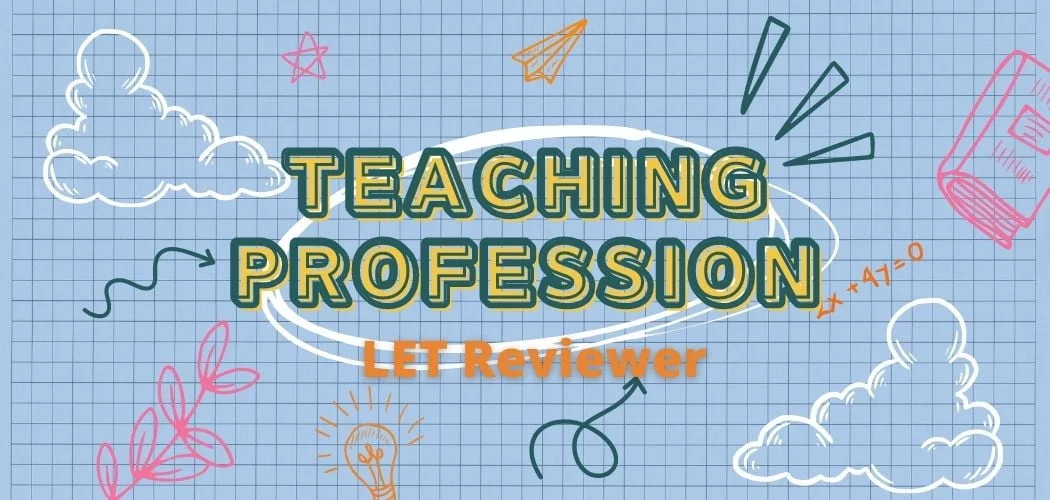Get a sense of the test questions in LET with our practice tests and exam. This will allow you to view which areas your strengths lie in and determine areas of improvement to pass the licensure exam for teachers.
You can either take the full mock quiz with Google Quiz or download the PDF file (with the answer key). This is the second part of the LET Reviewer for the General Education and Math Major series. You can find the first part here.
Recommended reading
- 5 Researched-Based Techniques to Pass the LET
- 13 Tips from Repeaters: How to Pass LET the First Time
- How to Remember Better: A Study Tip for Your Exam
LET Reviewer: Math Major
Question 1. For a distribution of scores, which of the following z-score values represents the location closest to the mean?
A. z = –2.00
B. z = –1.00
C. z = +0.50✅
D. z = +1.00
Question 2. For a population with 𝜇=80 and 𝜎=12, what is the z score corresponding to X=92?
A. z = +12.00
B. z = +1.20
C. z = +1.00✅
D. z = +0.50
Question 3. For the past 20 years, the high temperature on April 15th has averaged 𝜇=62 degrees with a standard deviation of 𝜎=4. Last year, the high temperature was 72 degrees. Based on this information, which of the following best describes last year’s temperature on April 15th?
A. There is not enough information to compare last year with the average.
B. Above average, but it is impossible to describe how much above average.
C. Far above average.✅
D. A little above average.
Question 4. If two events are mutually exclusive, can they occur concurrently?
A. Yes. By definition, mutually exclusive events can occur together.
B. No. By definition, mutually exclusive events cannot occur together.✅
C. No. Two events will never occur concurrently.
D. Yes. Any two events can occur concurrently.
Question 5. For a normal distribution, is it likely that a data value selected at random is more than 2 standard deviations above the mean?
A. No. This event happens only 16% of the time.
B. No. This event happens only .015% of the time.
C. No. This event happens only 2.5% of the time.✅
D. Yes. This event happens quite frequently.
Question 6. On a single toss of a fair coin, the probability of heads is 0.5 and the probability of tails is 0.5. If you toss a coin twice and get heads on the first toss, are you guaranteed to get tails on the second toss?
A. Yes, since the coin is fair.
B. No, each outcome is equally likely regardless of the previous outcome.✅
C. Yes, tails will always result in the second toss.
D. No, tails will never occur on the second toss.
Question 7. Consider a Statistics class with 45 female students and 55 male students. Only 25 females passed a difficult midterm exam, whereas 30 males passed the same exam. What is the probability that a randomly chosen student passed the exam?
A. 55%✅
B. 25/45
C. 45%
D. 1/4
Question 8. Consider the probability distribution of a random variable x. Is the expected value of the distribution necessarily one of the possible values of x?
A. No. The expected value can be a value different from the exact value of x.✅
B. Yes. The expected value must always be one of its possible values of x.
C. Yes. The expected value can never be a value from the exact value of x.
D. No. The expected value will never be one of its possible values of x.
Question 9. What does the random variable for a binomial experiment of n trials measure?
A. The random variable measures the standard deviation of n trials.
B. The random variable measures the number of failures out of n trials.
C. The random variable measures the number of successes out of n trials.✅
D. The random variable measures the mean of n trials.
Question 10. Consider two normal curves. If the first one has a larger mean than the second one, must it have a larger standard deviation as well?
A. No. The values of 𝜇 and 𝜎 are independent.✅
B. Yes. The values of 𝜇 and 𝜎 are independent.
C. No. As 𝜇 increases, 𝜎 will decrease.
D. Yes. As 𝜇 increases, 𝜎 must also increase.
Question 11. Raul received a score of 78 on a history test for which the class mean was 70 with a standard deviation of 8. He received a score of 74 on a biology test for which the class mean was 70 with a standard deviation of 4. On which test did he do better relative to the rest of the class?
A. biology test
B. history test
C. the same✅
D. none
Question 12. Police response time to an emergency call is the difference between the time the call is first received by the dispatcher and the time patrol car radios that it has arrived at the scene. Over a long period of time, it has been determined that the police response time has a normal distribution with a mean of 6.0 minutes and a standard deviation of 1.5 minutes. For a randomly received emergency call, find the probability that the response time is between 3 and 7 minutes.
A. 0.2525
B. 0.0228
C. 0.7248✅
D. none
Question 13. Coal is carried from a mine in West Virginia to a power plant in New York in hopper cars on a long train. The automatic hopper car loader is set to put 58 tons of coal into each car. The actual weights of coal loaded into each car are normally distributed, with mean 𝜇=58 tons and standard deviation 𝜎=1 ton. Suppose the weight of coal in 45 cars selected at random had an average x of less than 57.5 tons. Would that fact make you suspect that the loader had slipped out of adjustment?
A. Yes, the probability that this deviation is random is very small.✅
B. Yes, the probability that this deviation is random is very large.
C. No, the probability that this deviation is random is very small.
D. No, the probability that this deviation is random is very large.
Question 14. Let x be a random variable that represents white blood cell count per cubic milliliter of whole blood. Assume that x has a distribution that is approximately normal, with mean 𝜇=7100 and estimated standard deviation 𝜎= 850. A test result of x<3500 is an indication of leukopenia. This indicates bone marrow depression that may be the result of a viral infection. What is the probability that, on a single test, x is less than 3500?
A. 0.1033✅
B. 0.1133
C. 0.1233
D. 0.1333
Question 15. One of the top-paid female wrestlers is 28 years old. If her age is 0.55 standard deviations below the mean, and the standard deviation for female wrestlers’ ages is 5.9 years, what is the average age for all female wrestlers? Assume that female wrestler ages can be modeled with a normal distribution.
A. not enough information is given
B. 31.2✅
C. 23.3
D. 24.8
Question 16. Consider a family with 4 children. Assume the probability that one child is a boy is 0.5 and the probability that one child is a girl is also 0.5 and that the events “boy” and “girl” are independent. What is the probability that all 4 children are male?
A. 1/16✅
B. 2/16
C. 3/16
D. 4/16
Question 17. You flip a fair coin (i.e., the probability of obtaining Heads is 1/2) three times. Assume that all sequences of coin flip results, of length 3, are equally likely. Determine the probability of any sequence in which the number of Heads is greater than or equal to the number of Tails.
A. 1/2✅
B. 1/4
C. 3/8
D. 3/16
Question 18. Consider two discrete probability distributions with the same sample space and the same expected value. Are the standard deviations of the two distributions necessarily equal?
A. No, the individual probabilities may differ in a way that produces the same expected value but a different standard deviation.✅
B. No, the standard deviations of two different discrete probability distributions are never equal.
C. Yes, because both distributions have the same expected value, they will have the same standard deviation as well.
D. Yes, because both distributions have the same sample space, they will have the same standard deviation as well.
Question 19. In an experiment, there are n independent trials. For each trial, there are three outcomes, A, B, and C. For each trial, the probability of outcome A is 0.50; the probability of outcome B is 0.20; and the probability of outcome C is 0.30. Suppose there are 10 trials. Can we use the binomial experiment model to determine the probability of four outcomes of type A, five of type B, and one of type C?
A. Yes. Each outcome has a probability of success and failure.
B. Yes. A binomial probability model applies to three outcomes per trial.
C. No. A binomial probability model applies to only one outcome per trial.
D. No. A binomial probability model applies to only two outcomes per trial.✅
Question 20. Consider the following scores. How do the two scores compare relative to their respective distributions?
(i) a score of 40 from a distribution with a mean of 50 and a standard deviation of 10
(ii) a score of 45 from a distribution with a mean of 50 and a standard deviation of 5.
A. They are both 1 standard deviation below their respective means.✅
B. They are both 2 standard deviations below their respective means.
C. They are both 1 standard deviation above their respective means.
D. The score of 40 is 2 standard deviations below its mean, while the score of 45 is only 1 standard deviation below its mean.



